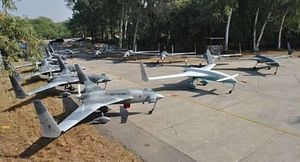Rakshit Kweera

India witnessed a significant drone attack at the Air Force Station in Jammu on June 27, 2021. The airbase, which is 14 km away from the India-Pakistan border, was attacked by low–flying drones that dropped two improvised explosive devices (IEDs). One IED exploded on the roof of the building, and the other in an open area. This one-off incident shook the security establishment.
Drone incursions across the border have intensified since then. Drone sightings have increased manifold along the India–Pakistan international border and along the Line of Control (LOC) in Kashmir. India’s Border Security Force (BSF), which guards the international border on the Indian side, reported more than 268 drone sightings in 2022, compared to 109 in 2021 and 49 in 2020.
The rapid growth in drone sightings suggests that drones have emerged as a new strategic tool used by Pakistan to gain an advantage in the border conflict with India. Drones are also increasingly a tool of choice for transborder terrorist organizations and Pakistan-backed proxies in India. Drones can be used for both kinetic operations – attacks in military and civilian spaces – and non-kinetic operations, in which drones are used to smuggle counterfeit currency, drugs, small arms, and ammunition across the border. The latter is significantly felt across the Punjab border, where narco–terrorism has intensified. The capture and occasional shoot-down of drones carrying drugs and arms are now regularly reported across the Punjab border.
In the Poonch terror attack on April 20, in which five soldiers were killed, it is reported that drones were used to drop weapons and cash to militants who carried out the attack.
The use of drones or unmanned aerial vehicles (UAVs) in conflict is now a global phenomenon, with non–state actors such as Yemen’s Houthi rebels coordinating major drone attacks on Saudi and Abu Dhabi oil facilities. The use of armed UAVs has also been observed in major conflicts such as in the Western Libyan military conflict of 2019–20, the Armenia–Azerbaijan conflict over the Nagorno–Karabakh region in 2020, and the ongoing Russia–Ukraine conflict. The reasons are manifold: their affordable cost and relatively simple technology make it easy for non–state actors to acquire and deploy drones, while their small size and technological features make it difficult to detect drones using modern radar and air-defense systems. In addition, UAVs make long-range precision strikes possible, thus reducing close combat on the battlefield and avoiding human losses.
In the India-Pakistan conflict scenario, the security implications are high. The inclusion of advanced UAVs in the arsenal of non-state actors will pose a major threat to the security establishment in India.
Pakistan has been a quick mover in the drone race with India. Pakistan was the fourth country in the world after the United State, United Kingdom, and Israel to successfully deploy an unmanned combat aerial vehicle (UCAV) in an active operation. In 2015, the Pakistan military claimed to have eliminated three high-profile Tehreek-e-Taliban Pakistan (TTP) terrorists using its indigenous Burraq combat drone during an operation in North Waziristan’s Shawal Valley. Apart from the Burraq, the Falco and GIDS Shahpur form Paksitan’s fleet of UCAVs. Pakistan is also a heavy importer of military UAVs from China and Turkey. These include Caihong (CH) 4 and Wing Loong UAVs from China, and Bayraktar Akinci UCAVs from Turkey.
India on the other hand has started to focus on UAVs as a military weapon. India is presently an importer of military drones from Israel and the United States. The Searcher Mark II, Heron II, Harpy, and the Harops are major UAVs from Israel. India and the United States are on the verge of completing one the biggest Predator drone deals, where India intends to buy 30 MQ 9B UAVs from the U.S. for $3 billion. The UAVs – 10 each for the three services – will strengthen national security and surveillance in the Line of Actual Control and the Indian Ocean.
In terms of indigenous drone development, India’s progress has been modest. Nishant was one of the Defense Research and Development Organization (DRDO)’s first tactical UAV projects, later upgraded to a wheeled version, Panchi. The indigenous MALE UAV development program of the DRDO reached a milestone in March 2022 with the Rustom-II crossing at an altitude of 27,500 ft with 18 hours of endurance.
India recently embarked upon a spree of reforms in the drone sector. This includes the formulation of industry-friendly civil Drone Rules, 2021, which aspire to make India the global drone hub of the world by 2030. This has given a boost to the private sector to enter the military drone market and advance the government’s Atmanirbhar Bharat (self-reliant India) policy in ammunition and defense systems. So far the trends are positive, as recently Economics Explosives Ltd, a fully-owned subsidiary of Solar Industries Nagpur, bagged an order to supply the UAV Nagastra to the Indian Army, beating competitors from Israel and Poland.
Coming back to the menace of drones on the India-Pakistan border, emerging anti–drone technology could give a tactical and strategic advantage to India vis-a-vis Pakistan. Small drones, which are low flying, are generally difficult to detect by radars and traditional air defense systems. Counter-unmanned aircraft systems (C-UAS) technology, as it is called, neutralizes enemy drones with “soft kill” (blocking communication lines) as well as “hard kill” (bringing down the drone) techniques. As India is majorly at the receiving end of drone incursions, investments in C-UAS will be more practical.
The DRDO has handed over D-4 (Drone, Detect, Deter, and Destroy) systems to the Army, but the BSF also needs to be guarded with anti-drone systems. Along with this, training BSF personnel in the new technologies is an immediate task at hand. Soon, we could see sophisticated Chinese drones being used by the non-state actors in Kashmir and along the international border. The security establishments in India need to be wary of this potential threat, and the deployment of C-UAS that are indigenously developed is the need of the hour.
No comments:
Post a Comment